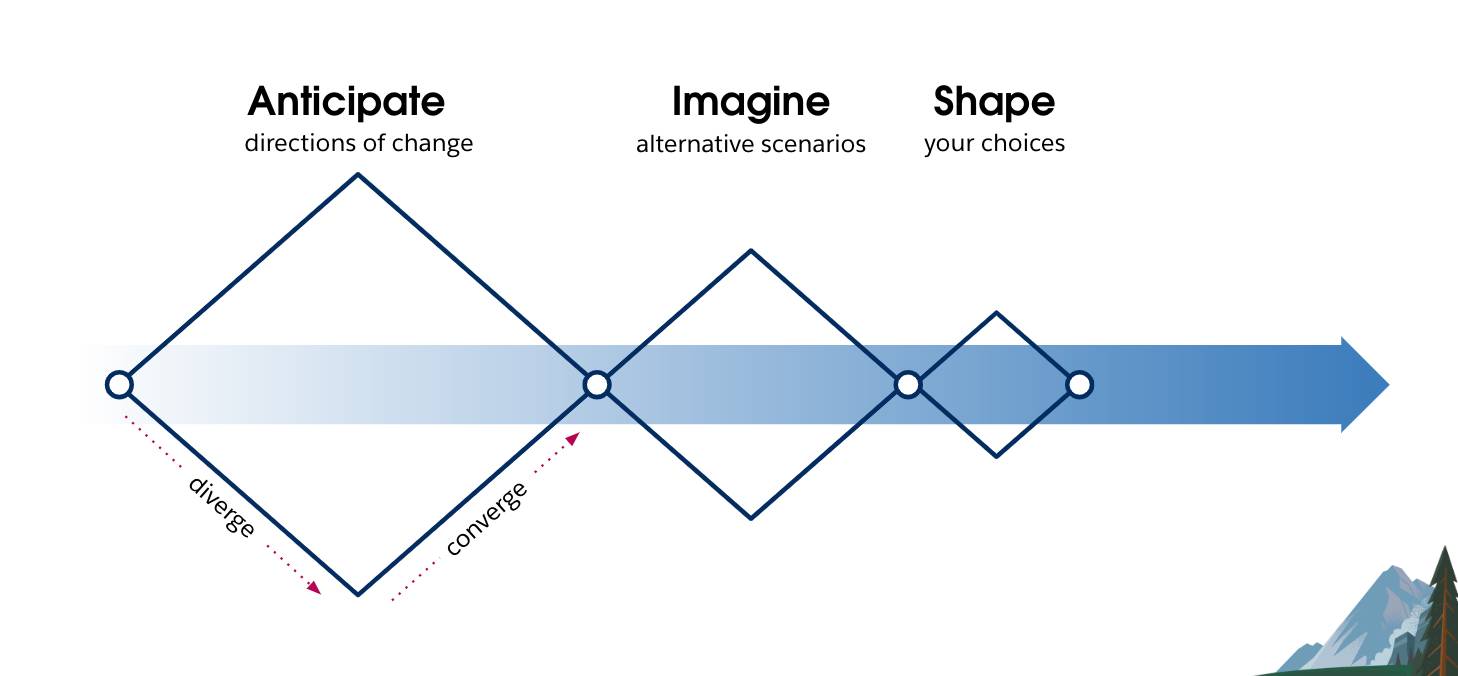Think Like a Futurist
Learning Objectives
After completing this unit, you’ll be able to:
- Explain the types of decisions that benefit from futures thinking.
- Describe the three steps in the Salesforce Futures approach.
Fasten Your Seatbelt
How many times have we all heard someone refer to the “rapid pace of change”? It’s a cliché for a reason—we live in an environment that is highly dynamic. Pandemics will continue to strike; climate change is driving increasingly extreme weather; geopolitics will be increasingly contentious; and the global economy is only getting more complex. The list goes on, and underneath the headlines, Fourth Industrial Revolution technologies are spreading faster than any previous waves of innovation.

Just stop for a moment to consider what you’ve gotten used to as a “normal” morning. Over breakfast, you might flip through headlines offering predictions of recession, new scientific data about how to eat, the odds of great-power conflict. You might read articles about a breakthrough in self-driving cars, a hacker breaking into to a major retailer, and a sudden shortage of critical goods. You have a mix of emotions about these things but mostly try to file the information away for later.
Switching to social media, you see a thread where a well-respected expert in your industry is arguing that the much-discussed potential for automation is overhyped. And they claim that impending job loss can be safely dismissed. You tend to agree, but you’re not sure whether you can rely on this advice. Scrolling down, you see someone else talking about the rising number of youth reporting mental health problems, which immediately makes your chest tighten with anxiety for your preteen daughter.
That’s a lot to take in! And your day has just begun. How do you keep up?
We All Need to Think Like Futurists
The constant thrum of change and uncertainty is why Salesforce created Salesforce Futures. Our team’s approach is to anticipate, imagine, and shape the future for Salesforce and our stakeholders.
In this era, it’s particularly important to stop and think about your biggest choices. But even in calmer times, we’re all constantly making decisions about the future, because major personal and organizational choices are always just around the corner.
Imagine your nephew is excited to go to college and wants your advice on how to choose a career. Perhaps a job offer just came along unexpectedly, and it’s in an industry you’ve never worked in. Maybe there’s a new competitor in your marketplace and you’re being asked for ideas on how to respond. Or you see a big problem with one of your team’s main service offerings, and you’re not sure how to solve it.

Source: Burst on Unsplash.
Each one of those choices involves taking an implicit position about what the future will hold, sometimes many years down the line. Those are the moments when futures thinking can help.
Personal Choices About the Future |
Organizational Choices About the Future |
|---|---|
|
|
Go through the list and select a decision that you face now, faced recently, or could face in the next 6 months. If you can, make it an organizational decision where you’ll need to involve more than just yourself in making the choice. Now, ask yourself this question, which we at Salesforce Futures always use with our stakeholders:
"Imagine you have access to an oracle (a being with perfect knowledge of the future) who can answer any question about the future, but only if it helps you make a better decision today. What would you ask?"
Crystal balls are make-believe, but it turns out that pretending that you’ve got a real one is actually quite valuable. When you’ve answered it for yourself, ask your other stakeholders.
Learn to Anticipate, Imagine, and Shape the Future
Contrary to popular belief, futurists aren’t oracles. They’re simply people who’ve learned to use futures thinking: a set of tools for asking better questions about the future.
In modern times, futurists were first found among military officers facing grim challenges in the early 20th century. They appeared again in the 1970s at major oil companies where they guided investment decisions. Today, those tools have been adapted for use at any size of organization, in any sector.
Futures thinking can help any leader cut through the noise and make better decisions. At Salesforce Futures, we use a three-step approach in our work.
-
Anticipate directions of change—to understand the various forces carrying us forward.
-
Imagine alternative scenarios—to find the particular possibilities that matter.
-
Shape our choices—to use those possibilities to spark new conversations.

We draw these steps as diamonds because each involves both divergent thinking to explore possibilities followed by convergent thinking to narrow down the options to the most valuable. As you’ll see in the units that follow, futures thinking involves constant cycling between the two, with the outputs of one creating inputs for the next.
The Salesforce Futures team uses these three steps to guide company leadership in seeing opportunities and risks early. For example, Chief Futures Officer Peter Schwartz has used these tools to inform Salesforce investments in voice recognition, our emerging-market strategy, the shift to the public cloud, and several major acquisitions.
We also use futures thinking to find opportunities for Salesforce to put its values into action. As a company, the ideas of trust, customer success, innovation, equality, and sustainability are not just ideals to aspire to ourselves. They are a state of affairs that we strive to create in the world. By looking ahead, we help the company find decisions today that can spread those values further.
For example, when the COVID-19 pandemic was just beginning in the early months of 2020, Schwartz recognized the threat and immediately began exploring scenarios for what might happen. With his Salesforce Futures team, he produced a series of deep investigations into how the pandemic could reshape society and the business environment over the coming months and years.
Take a look at the work we did in partnership with Deloitte in spring 2020 to see how much was visible right at the start. And in a later partnership with Accenture in the summer of 2021, we explored possible longer-term consequences of the Pandemic Era. We highlighted the ways that businesses could lead an effective pandemic response. And we worked with leaders across Salesforce to model that behavior in their own decisions.
Another example is the scenarios we built for paths to net zero carbon emissions. These scenarios contributed toward the adoption of sustainability as a corporate value, the creation of our Team Earth brand campaign, and the launch of Net Zero Cloud.
As of fall 2022, we’re currently developing perspectives on the pathways out of our current crisis of trust. We’re exploring possibilities for how geopolitical rivalries can reshape the internet and ideas on the pivotal role of relationships in stakeholder capitalism. Stay tuned!
Resources
- Article: The Pandemic Era Has Begun: How to Navigate Challenges and Opportunities in an Uncertain Future
- Report: The world remade by COVID-19: planning scenarios for resilient leaders
- External Site: The Cognitive Bias Codex
- Article: Author Talks: April Rinne on finding calm and meaning in a world of flux